#galerie maeght
Text

“ALBERTO GIACOMETTI” (GALERIE MAEGHT)
HENRI CARTIER-BRESSON // PARIS, 1961
[gelatin silver print | 17 3/5 × 11 7/10"]
#henri cartier-bresson#henri cartier bresson#alberto giacometti#film photography#analog#black and white#monochrome#paris#galerie maeght#modern art#60s#french#photography#u
342 notes
·
View notes
Text
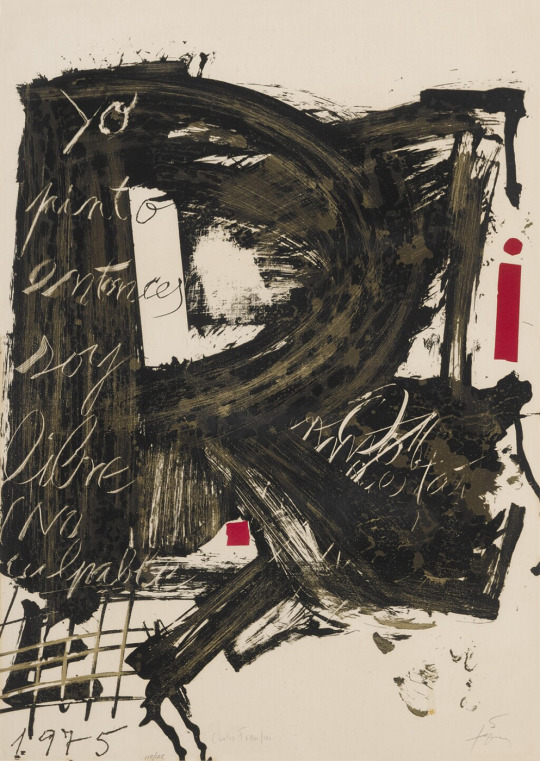
Antoni Tàpies, Poemas para mirar (Galfetti 537), (lithograph), Printed by Maeght, Paris, Published by Editart, Orlando et Dolorès Blanco, Genève, 1975, Edition of 125 [© Fundació Antoni Tàpies, Barcelona]
#art#mixed media#visual writing#lithograph#antoni tàpies#galerie maeght#editart#fundació antoni tàpies#1970s
70 notes
·
View notes
Text
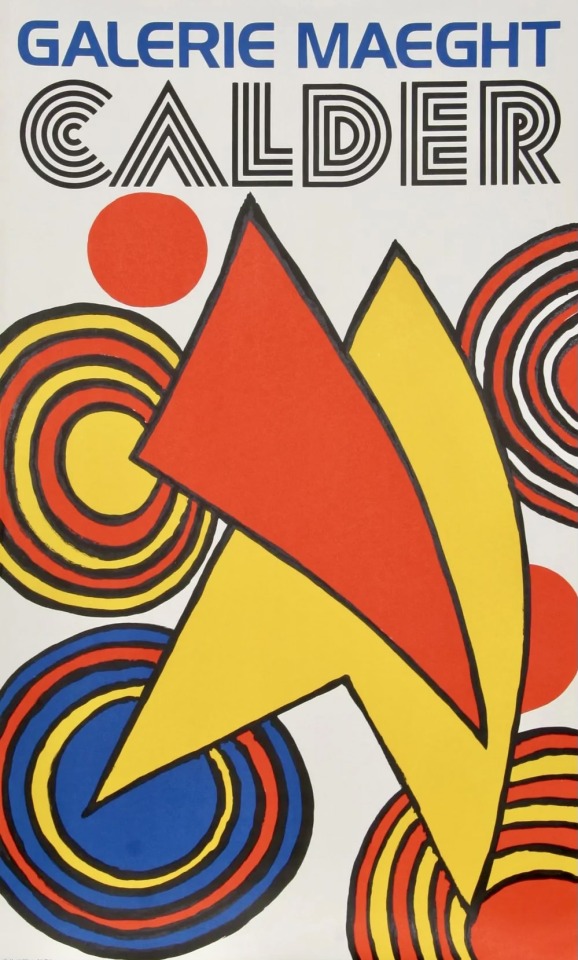
44 notes
·
View notes
Photo

Alexander Calder, Stabiles, Galerie Maeght, Paris, 1959
714 notes
·
View notes
Text

Michel Ginies
Francis Bacon à la galerie Maeght-Lelong, 1987
#francis bacon#michel ginies#film photography#portrait photography#photography#painter#artist#painting#art#fine art
73 notes
·
View notes
Text

Remedios Varo Uranga
Remedios Varo Uranga, née le 16 décembre 1908 à Anglès, dans la province de Gérone en Espagne, et morte le 8 octobre 1963 à Mexico, est une artiste peintre surréaliste espagnole.
Son père est un ingénieur hydraulique. En 1924, Remedios Varo entre à l'Académia de San Fernando où elle étudie les beaux-arts. En 1930, elle participe à une exposition collective à Madrid. Elle épouse le peintre basque Gerardo Lizarraga et ils partent s'installer à Paris.
Elle revient à Barcelone, en 1932, se sépare de Lizagarra et se lie avec le peintre Esteban Francés.
En 1936, Remedios Varo participe à l'exposition Logicofobista organisée à la Galeria Catalonia de Barcelone et rencontre le poète surréaliste français Benjamin Péret, venu combattre avec les anarchistes de la colonne Durutti sur le front de Teruel2. Ils se marient et s'installent à Paris en 1937. Avec Péret, elle fréquente le groupe surréaliste parisien et se lie d'amitié avec l'artiste peintre anglaise Leonora Carrington. Elle présente plusieurs tableaux à l' Exposition internationale du surréalisme de janvier 1938 et à l' Exposition du rêve dans l'art organisée par Frédéric Delanglade. Sa toile El Deseo (Le Désir) est reproduit dans le numéro 10 de la revue Minotaure.
À la fin de l'année 1940, Remedios Varo et Benjamin Péret retrouvent André Breton et quelques surréalistes réfugiés à Marseille, dans la villa Air-Bel, louée par le journaliste américain Varian Fry, dans l'attente d'un visa de sortie du territoire français. Ils parviennent à quitter la France en 1941 pour le Mexique. Elle y retrouve Lizarraga, Francés, Leonora Carrington, Gordon Onslow-Ford, Wolfgang Paalen et sa femme Alice Rahon. Elle crée des publicités pour la compagnie pharmaceutique Bayer, fait de la décoration, peint des meubles et restaure des céramiques pré-colombiennes.
En 1947, elle se sépare de Benjamin Péret qui rentre en France. Elle expose à la galerie Maeght pour l' Exposition internationale du surréalisme.
Après un voyage au Venezuela où elle participe, avec son frère le docteur Rodrigo Varo, à une expédition entomologique, Remedios Varo rencontre Walter Gruen qui l'encourage à peindre à nouveau. Ils se marient en 1953.
En 1955, la Galería Diana de Mexico organise sa première exposition personnelle. En 1958, la Galería Excelsior organise le premier Salon de la Plastica Femina où sont exposées des œuvres, outre celles de Remedios Varo, de Leonora Carrington et d’Alice Rahon. En 1962, la Galería Juan Martín présente sa deuxième exposition personnelle et elle participe à l'Exposition internationale de Tokyo.
Remedios Varo meurt d'une crise cardiaque. Son dernier tableau Nature morte ressuscitant est la seule œuvre sans aucun personnage.
En 1964, une rétrospective est organisée au Musée des Beaux-Arts de Mexico qui attire plus de 50 000 visiteurs. Dans la revue surréaliste La Brèche, André Breton rend hommage à son œuvre « tout entière » surréaliste : « Remedios, la féminité même, ici en hiéroglyphe le jeu et le feu dans l'œil de l'oiseau. »
12 notes
·
View notes
Text
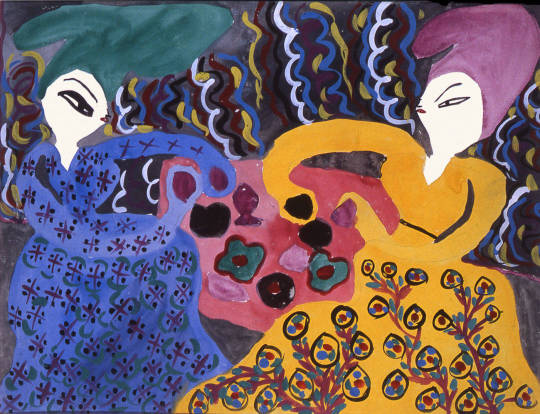


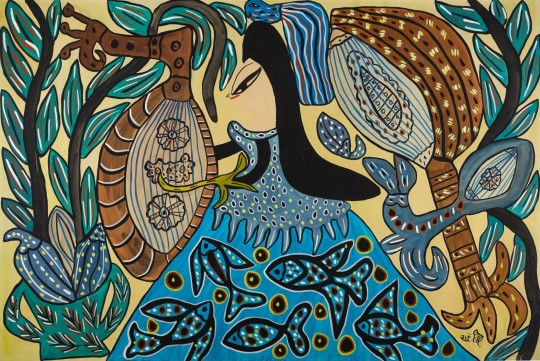


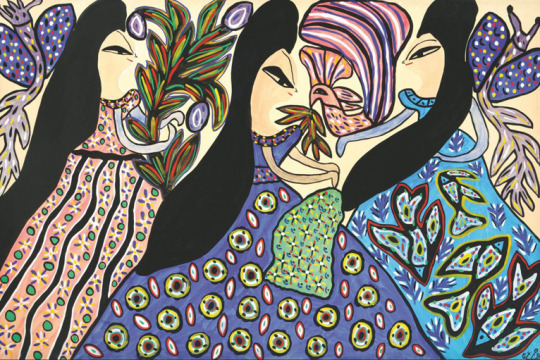



Baya was born Fatma Haddad (1931 - 1998), in Bordj el-Kiffan, a beachy suburb of the city of Algiers, at the North-Western tip of Africa. Orphaned by age 5, she was adopted as a teenager by Marguerite Camina Benhoura, a French intellectual who noticed Baya’s artistic talent from a young age. In her homes in Algiers and the South of France, Benhoura provided Baya with art materials and access to French and Maghrebi art magnates.
In 1947, when Baya was just 16, she was discovered by Aimé Maeght, an established French art dealer, and André Breton, who included Baya’s works in the Exposition Internationale du Surréalisme at Galerie Maeght in Paris. Almost overnight she caught the attention of Picasso and Matisse, among other prominent artists, for her colorful, spontaneous and “childlike” compositions. “Her work allows us to question so many different histories,” said curator Natasha Boas. “The outsider. The outlier. The woman artist.”
Boas decided on the title, “Baya: Woman of Algiers,” drawing from three points of inspiration: a book by Assia Djebar, the leading feminist theorist from the Maghrebi region of North Africa, titled Women of Algiers in Their Apartment; Picasso’s The Women of Algiers series (1955) inspired by Baya herself; and The Battle of Algiers, a 1966 film directed by Gillo Pontecorvo, based on events during the Algerian War (1954-62).
https://www.thecut.com/.../the-algerian-teenager-who...
33 notes
·
View notes
Photo

Jacques Monory (1924-2018) - Technicolor n°8, 1977
Huile sur toile (150 x 150 cm)
Galerie Maeght, Paris
15 notes
·
View notes
Text
¿La Web del surrealismo? Clovis Trouille (1889-1975)
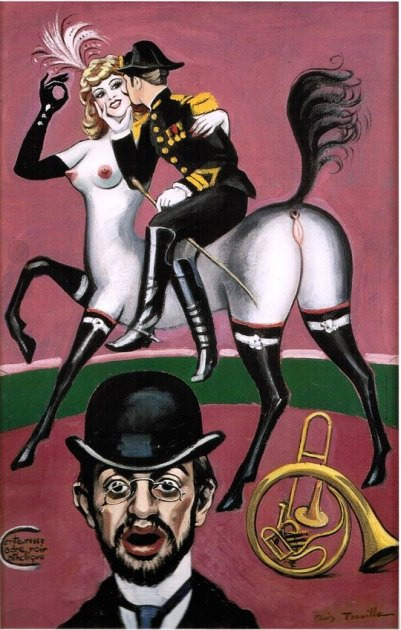
Clovis Trouille no era realmente un surrealista, sin embargo, en 1930 Dali y Aragon descubrieron la pintura contra la guerra de Clovis Trouille Remembrance en el Salón de pintores y escritores revolucionarios. André Breton lo consideró "el gran maestro de todo vale", y se ofreció a exhibir sus obras en su galería pero él se negó por temor a que lo etiquetaran de esa manera.
Nació en 1889 en La Fère, la región de Picardía de Francia y de 1905 a 1910 estudió en la École des Beaux-Arts de Amiens, y en 1907 su pintura La chica rubiaSe llevó el primer premio de Bellas Artes de Amiens. Además de pintura, Trouille estudió moda y publicidad, y trabajó como diseñador para chez Draeger. Sus experiencias en el frente en la Primera Guerra Mundial le dieron un odio de por vida hacia los militares y lo volvieron bastante anarquista.
Trouille exhibió regularmente su trabajo en ferias y pequeños espectáculos independientes, pero logró pocas ventas y, en cambio, trabajó en una tienda por departamentos en París restaurando y decorando sus maniquíes. Trouille siempre quiso permanecer independiente de las principales galerías. En 1947 rompió con la tradición y participó en la Exposición Internacional de Surrealismo organizada por André Breton y Marcel Duchamp en la Galería Maeght de París, pero pasaron doce años más antes de que se uniera a otra gran muestra, la Exposición Eros internationale Surréaliste en la Galerie. Daniel Cordier en París.
#Clovis Trouille Remembrance en el Salón de pintores y escritores revolucionarios. André Breton lo consideró el gran maestro de todo vale#¿Esta es la imagen y algunos datos (O no) la “Historia” la pones tú? ¡La tuya! ¿Lo harás...?#Surrealista
26 notes
·
View notes
Text
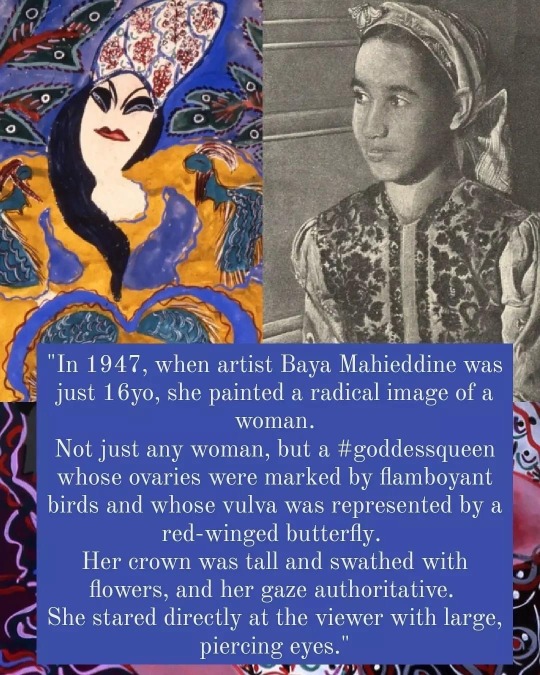


"In 1947, when artist Baya Mahieddine was just 16 years old, she painted a radical image of a woman. Not just any woman, but a goddess-queen whose ovaries were marked by flamboyant birds and whose vulva was represented by a red-winged butterfly. Her crown was tall and swathed with flowers, and her gaze authoritative. She stared directly at the viewer with large, piercing eyes."


Let's read it gain: Artist Baya Mahieddine, The Algerian Teenager Who Painted a World of Liberated Women in 1940s Paris, by Alexxa Gotthardt, Feb 5, 2018 www.artsy.net/article/artsy-editorial-algerian-teenager-painted-liberated-women-1940s-paris
Photo: Portrait of Baya Mahieddine.
Courtesy of Galerie Maeght.
Baya, Femme robe jaune cheveux bleus (Woman with blue hair in a yellow dress), 1947.
Baya, Femme allongée au visage bleu (Reclining woman with blue face), 1947.
Baya, Femme et oiseau en cage (Woman with a caged bird), 1947.
Baya, Femme et enfant en bleu (Woman and child in blue), 1947.
Baya, Femme attablées (Women at table), 1947. All artwork's photos © Galerie Maeght, Paris. Courtesy of Grey Art Gallery.
Baya Mahieddine (Arabic: باية محي الدين) or Fatima Haddad (Arabic: فاطمة حداد, born in Bordj El Kiffan on Dec 12, 1931; died Nov 9, 1998) was an Algerian artist.
While she did not self-identify as belonging to a particular art genre, critics have classified her paintings as being surrealist, primitive, naïve, and modern.
Her works are mainly paintings, though she did pottery as well, all completely #selftaughtartist.
At the age of sixteen Baya had #herfirstexhibition, in Paris, where she gained notice from renowned artists. Her work was presented in various exhibitions in #France and #Algeria, and has appeared on Algerian postage stamps.
She did not paint from 1953 to 1963, which coincides with the #AlgerianWar. During these years she gave birth and was mothering six children. In 1963 she resumed painting, exhibiting both new and old work in Algiers and in Paris, until her death on Nov 9, 1998 (age 66)
#BayaMahieddine #womensart #artbywomen #womeninarts
2 notes
·
View notes
Text

Alberto Giacometti et "L'Homme qui marche" photographiés par Henri Cartier-Bresson à la Galerie Maeght, Paris, 1961
11 notes
·
View notes
Photo
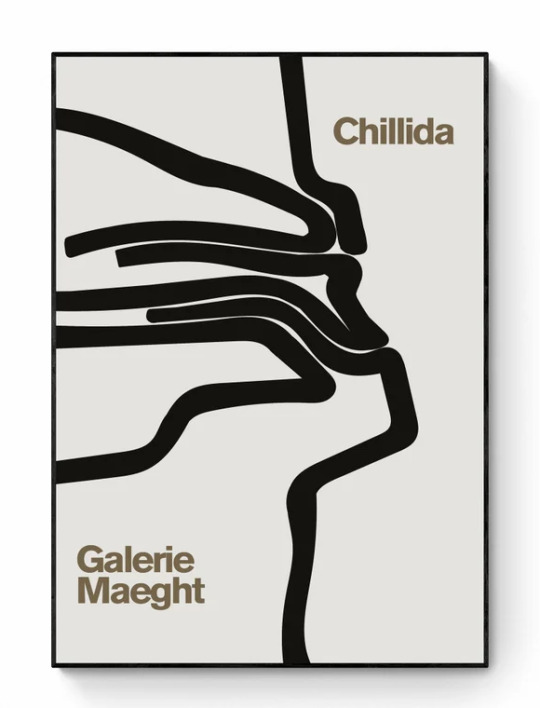
Eduardo Chillida - Exhibition Poster
https://www.etsy.com/uk/listing/914501656/eduardo-chillida-galerie-maeght
6 notes
·
View notes
Photo

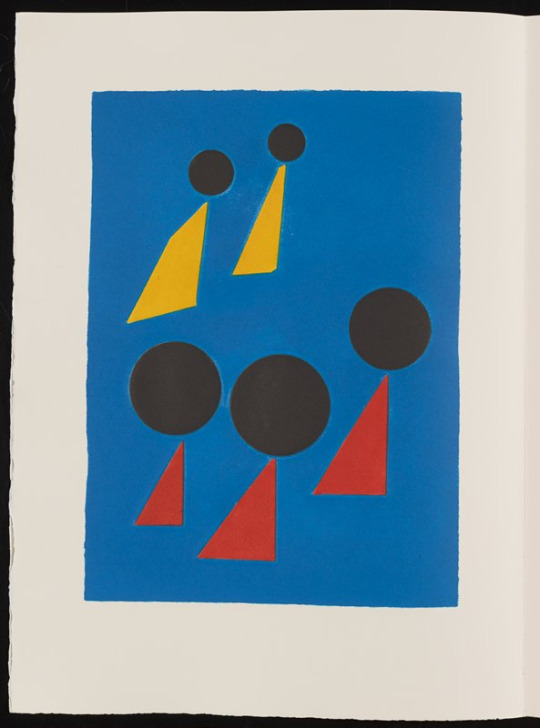
From: Alexander Calder – Jacques Prévert, Fêtes, (color aquatints, letterpress; bound volume), Galerie Maeght, Paris, 1971, Edition of 225 copies, signed by Calder and Prévert [© Calder Foundation, New York, NY / ARS, NY / Adagp, Paris]
#graphic design#art#aquatint#drawing#illustration#geometry#book#alexander calder#jacques prévert#galerie maeght#calder foundation#1970s
69 notes
·
View notes
Photo

Maurice Baskine, Le Magicien de la Matière
Exhibition invitation card for one of the earliest - quite possibly the first - and very few solo exhibitions by the alchemist-painter Maurice Baskine. The Ukrainian born artist moved in Paris as a child. In the late 1930s he discovered texts of the seventeenth- century Scottish alchemist Alexander Sethon initiating him in art and occultism at the same time. His work exhibited in.a group show in 1945 caught the eye of Jean Dubuffet while a couple of years later - after his participation in Galerie Maeght’s 1947 surrealism exhibition - André Breton asked him to illustrate a deluxe edition of his Arcana 17 with 3 apocryphal etchings. Baskine remained a mysterious and marginal personality dabbling in surrealist circles calling himself the “the last of the alchemists, first fantasopher”
via @bentpriorities IG
#maurice baskine#le magicien de la matière#exhibition invitation card#surrealism#art brut#surrealisme#alchemy#magic#esoterica#andre breton#bent priorities catalogue#bent priorities
3 notes
·
View notes
Text
FONDATION ANNETTE E ALBERTO GIACOMETTI: “ANNETTE EN PLUS INFINITEMENT”

Al pari di tante modelle "di professione" come Suzanne Valadon, Fernande Olivier o la famosissima Kiki de Montparnasse, Annette Giacometti è il soggetto incontrastato di un enorme quantità di opere di Alberto Giacometti, suo marito, un caso quasi unico di identificazione e simbiosi tra artista-modella e opera. Del resto le parole di Giacometti alla madre in una lettera del 1949 lasciavano pochi dubbi: "...C'est la seul femme avec laquelle je peux vivre e qui me rend possible d'etre complètment dans mon travail..." Ed è proprio merito di Annette se, dopo la morte di Alberto, prende vita la "Fondation Albert ed Annette Giacometti" di Parigi, che proprio quest'anno celebra un doppio anniversario: il centenario della nascita della sua fondatrice e i vent'anni della creazione della Fondazione, celebrati degnamente dalla magnifica mostra "Annette en plus infinitement”, allestita proprio nello scrigno della Fondazione in Rue Victor Schoelcher a Parigi, nel cuore di Montparnasse. Vale la pena spendere due parole sull'edificio o meglio “hotel particulier” di Paul Follot (1877-1941) in perfetta Art Déco che ha ospitato sia lo studio dell'architetto sia il suo appartamento. Oggi nell'Hotel Follot è stato ricostruito l'atelier di Giacometti e sono state ricavate piccole e deliziose sale espositive, la biblioteca e l'archivio dell’istituto Giacometti. La mostra, curata da Thierry Pautot, comprende una ragguardevole serie di busti, realizzati a partire dal 1946, dopo il ritorno di Giacometti a Parigi e caratterizzati da una materia "consumata" che fu cifra stilistica del grande scultore svizzero. Alberto conosceva tanto bene la sua modella, da saperla ritrarre perfettamente "a memoria". Come si sa Alberto Giacometti si concentrò su pochi soggetti come i busti, i ritratti, la figura in movimento, i volti, il naso e poco altro; la sua fu una ricerca sulla profondità psico-esistenziale di pochissimi soggetti, una ricerca verticale più che orizzontale. Di grande interesse anche i nudi, soggetto d'elezione per la Parigi delle avanguardie. Pieni di fascino particolare quelli di una ieratica Annette, con le braccia serrate lungo il corpo in posizione frontale. Bello il logo della Fondazione con la silhouette della scultura all’interno della Galerie a Maeght di Parigi fotografata da Henri Cartier-Bresson. La mostra, aperta fino al prossimo 27 settembre si completa con un piccolo apparato fatto di schizzi, quaderni di appunti, lettere e qualche fotografia, una di grande fascino che ritrae Alberto che a sua volta ritrae Annette. Un'altra gemma preziosa in una città già ricolma di una miriade di piccoli gioielli.

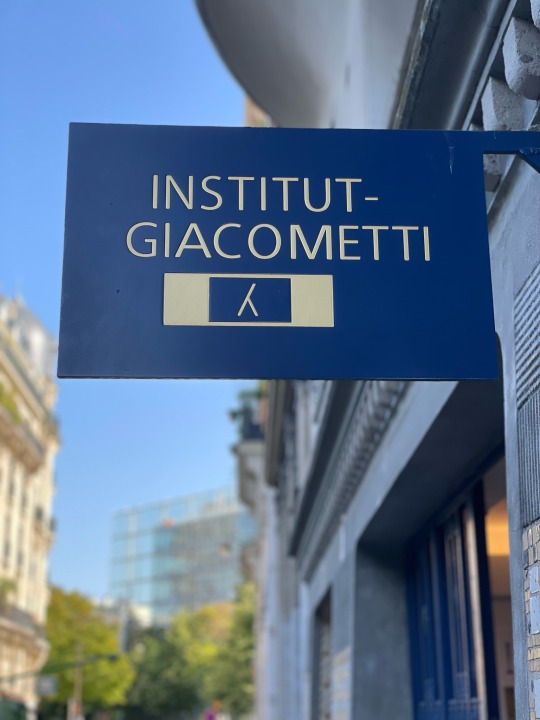
1 note
·
View note
Photo

Vernissage d’Aki Kuroda dans l’ancienne galerie d’ Anne de Villepoix. Des peintures fortes, lyriques et exploses de couleurs Yoyo Maeght Aki Kuroda (à Rue de Montmorency) https://www.instagram.com/p/ClUhE-GtNnO/?igshid=NGJjMDIxMWI=
0 notes